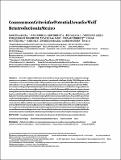Por favor, use este identificador para citar o enlazar a este item:
http://hdl.handle.net/10261/67254COMPARTIR / EXPORTAR:
 SHARE SHARE
 CORE
BASE CORE
BASE
|
|
| Visualizar otros formatos: MARC | Dublin Core | RDF | ORE | MODS | METS | DIDL | DATACITE | |

| Título: | Consensus on Criteria for Potential Areas for Wolf Reintroduction in Mexico |
Autor: | Araiza, M.; Carrillo, Luis; List, R.; González, C.A.L.; Martínez-Gutiérrez, Patricia G. CSIC ORCID; Moctezuma, O.; Sánchez-Morales, N.; Servín, Jorge | Fecha de publicación: | 2012 | Editor: | Blackwell Publishing | Citación: | Conservation Biology 26: 630- 637 (2012) | Resumen: | Given the conflict with human interests that in many cases results in the extirpation of large carnivores, acceptance of their reintroduction is a considerable challenge. By the 1980s Mexican wolves (Canis lupus) were extinct in the wild. In 1998 a population was reintroduced in the Blue Range Mountains of New Mexico (U.S.A.). Efforts to reintroduce the species in Mexico have been ongoing since the late 1980s. Four teams working independently identified 6 areas in northern Mexico in the historic range of Mexican wolves, where reintroductions could potentially be successful. Each team used different methods and criteria to identify the areas, which makes it difficult to prioritize among these areas. Therefore, members of the different teams worked together to devise criteria for use in identifying priority areas. They identified areas with high, intermediate, and low potential levels of conflict between wolves and humans. Areas with low potential conflict had larger buffers (i.e., distance from human settlement to areas suitable for wolves) around human settlements than high- and intermediate-conflict areas and thus were thought most appropriate for the first reintroduction. High-conflict areas contained habitat associated with wolf presence, but were closer to human activity. The first reintroduction of Mexican wolves to Mexico occurred in October 2011 in one of the identified low-conflict areas. The identification of suitable areas for reintroduction represents a crucial step in the process toward the restoration of large carnivores. Choice of the first reintroduction area can determine whether the reintroduction is successful or fails. A failure may preclude future reintroduction efforts in a region or country. © 2012 Society for Conservation Biology. | URI: | http://hdl.handle.net/10261/67254 | DOI: | 10.1111/j.1523-1739.2012.01888.x | Identificadores: | doi: 10.1111/j.1523-1739.2012.01888.x issn: 0888-8892 |
| Aparece en las colecciones: | (EBD) Artículos |
Ficheros en este ítem:
| Fichero | Descripción | Tamaño | Formato | |
|---|---|---|---|---|
| j.1523-1739.2012.01888.x.pdf | 690,67 kB | Adobe PDF |  Visualizar/Abrir |
CORE Recommender
SCOPUSTM
Citations
17
checked on 22-abr-2024
WEB OF SCIENCETM
Citations
17
checked on 25-feb-2024
Page view(s)
296
checked on 22-abr-2024
Download(s)
455
checked on 22-abr-2024
Google ScholarTM
Check
Altmetric
Altmetric
NOTA: Los ítems de Digital.CSIC están protegidos por copyright, con todos los derechos reservados, a menos que se indique lo contrario.
